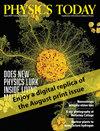Extreme weather makes monitoring snowpack increasingly relevant
IF 2.8
3区 物理与天体物理
Q2 PHYSICS, MULTIDISCIPLINARY
引用次数: 0
Abstract
A dedicated satellite would provide global coverage to improve understanding of the hydrologic cycle and inform water-use and risk-management strategies.极端天气使得监测积雪变得越来越重要
一颗专用卫星将提供全球覆盖,以增进对水文循环的了解,并为水资源利用和风险管理战略提供信息。
本文章由计算机程序翻译,如有差异,请以英文原文为准。
求助全文
约1分钟内获得全文
求助全文
来源期刊

Physics Today
物理-物理:综合
CiteScore
1.80
自引率
20.00%
发文量
423
期刊介绍:
Physics Today, the flagship publication of the American Institute of Physics, is the most influential and closely followed physics magazine in the world.
The mission of Physics Today is to be a unifying influence for the diverse areas of physics and the physics-related sciences. It does that by providing authoritative, engaging coverage of physical science research and its applications without regard to disciplinary boundaries; by reporting on the often complex interactions of the physical sciences with each other and with other spheres of human endeavor; and by offering a forum for the exchange of ideas within the scientific community. With authoritative features, full news coverage and analysis, and fresh perspectives on technological advances and ground-breaking research, Physics Today informs readers about science and its role in society.
Physics Today Online, the magazine’s internet home, presents the digital edition of the monthly print magazine and provides a valuable online archive of content going back to 1948. In addition, PTOL extends the magazine’s coverage with daily posts that capture what the physical science community is talking about—and what it will be talking about. Regular content from the magazine’s contributors and editorial staff includes commentaries, book reviews, and coverage of the latest research and science policy developments.
 求助内容:
求助内容: 应助结果提醒方式:
应助结果提醒方式:


